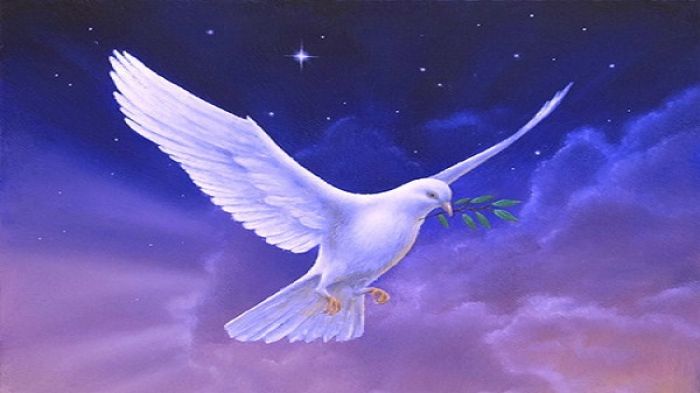Lupe Fano (Long-distance Flying Dove) Featured

Kolomu ‘Aati & Litilesa, Faiva Ta‘anga & Faiva Hiva (Art & Literature, Poetry & Music Column)
Lupe Fano (Long-distance Flying Dove)
Ta‘anga hiva viki (Song of praise)
Fakafatu-fakafa‘u ‘e Semisi ‘Iongi (Poetry composed by Semisi ‘Iongi) & Fakaafo-fakafasi ‘e Peni Latu Langi (Music composed by Peni Latu Langi)
Liliulea ‘Ingilisi ‘e (English translation by) Fetongikava Dr Viliami Uasike Latu & Hufanga He Ako Moe Lotu Professor Dr ‘Okusitino Mahina
Kupu, veesi, 1
Lupe[1] fano ‘ihe fetu‘ufuka
Takafia e la‘a moe ‘otu nepula
Kaveinga ko si‘ene mafua[2]
Koe ola ‘oe tavatavai Manuka[3]
Kupu, veesi 2
He ‘oku tatau ‘ae tua moe palai[4]
Kae tuku ‘eta matalafo[5] laukai
Koe muivaka ‘ae folau tongiaki[6]
Na‘e fefe ho‘o kau he‘emau telekaki?
Kupu, veesi 3
Mauifusifonua[7] pea tauala
‘One tuku ‘a Tonga kihe olovaha[8]
‘Eva laukau ‘ihe fonua mana
Nofo he nonga kae toe holivaka[9]
Tau
Fangu[10] mahua mei falelahi
Fakafunga ‘ae laumanu-ekiaki[11]
Moto e helilala ve‘eve‘e ‘oe Paki[12]
‘Elito e lolo ‘alaha kei tangitangi[13]
Verse 1
Long-distance flying dove[1] amongst the stars
Circling the sun and nebulae
In searching for food[2], her aim
Of secrets, of knowledge at Manuka[3]
Versus 2
Forget not, that tua is equal to palai[4]
Watchers at lafo[5] not allowed to count scores
Though following, mind the tongiaki fleet[6]
How did you join our boat race?
Verse 3
Mauifusifonua[7], fisher-of-land
Placing Tonga at the bow[8]
Walking with pride, in a magical land
Be settled, while you‘re aboard a boat[9]
Chorus
Tipped out of the fangu[10] from the royal house
Precious treasure of the white birds[11]
Bud of the heilala flowers of the Paki[12]
Essence of sweet-scented oil fragrance[13]
[1] ‘Oku ngaue‘aki ‘ae lupe, ‘o hange koe mahina, koe heliaki kihe ‘eiki fefine, ‘o hange ko Kuini Salote, pea moe hiva kakala kihe fefine (Doves, or pigeons, like the moon, are used as a metaphor for female monarchs, like Queen Salote, as well as in love poetry generally for women).
[2] ‘Oku ngaue‘aki ‘ae mafua koe heliaki kihe me‘akai ‘ae lupe moe ika (Mafua is used as a more formal term for food for doves, pigeons, and fish).
[3] ‘Oku ‘uhinga ki Manu‘a ‘i Ha‘amoa, ‘aia ‘oku ui fakaTonga koe Manuka, ‘o hange koe fale fa‘aManu‘a, ‘aia ‘oku ‘iloa ‘i Tonga koe fale fakaManuka (moe fale maota fakaHa‘amoa koe fale ha‘ota fakaTonga) (The place Manu‘a in Samoa is Manuka in Tonga, as in the Manu‘a house in Samoa and Manuka house in Tonga (as in fale maota in Samoa [Samoan maota house] and fale ha‘ota in Tonga [Tongan ha‘ota house]).
[4] ‘Oku fakatatau ‘ae ongo ‘ufi koe tua moe palai, ‘aia ‘oku ‘ikai koha ‘ufi ‘eiki ka koe ‘ufi tu‘a, ‘o ngaue‘aki he ongo lea Tonga heliaki koe, “‘Oku tatau ‘ae tua moe palai” moe “Fakamotu‘a kae ta‘o ha tua” (‘aia ‘oku ‘ikai ‘uhinga kihe liliu fakasino ka koe liliu faka‘atamai, fakafakakaukau, mo fakaongo, fakaloto, ‘o faka‘ilo‘ilo mo fakapotopoto (The yam tua is equated to the yam palai as commoner yams, as in the two heliaki, proverbial sayings, “Forget not, that tua is equal to palai” and “Try and be old that you bake a tua” [which is not physical but rather both psychological and emotional change]).
[5] ‘Oku ma‘u ‘ae lea Tonga heliaki koe, “‘Oku tapu ‘ae matalafo laukai” mei he faiva lafo, ‘aia na‘e ‘iai hono kau faiva moe kau laukai (The Tongan lea heliaki, proverbial saying, “‘A watcher at a lafo game not allowed to count scores, points” is derived from the performance art of lafo-throwing discs, faiva lafo, except for both the performers and referees themselves).
[6] ‘Oku kau ‘ae tongiaki he vave moe oma he fa‘ahinga ‘oe vaka, ‘o hange koe kalia moe tafa‘anga (Besides tongiaki, which are swift-sailing canoes, there are kalia and tafa‘anga and others).
[7] Na‘e toe ‘iloa ‘a Mauikisikisi ko Mauifusifonua, ‘aia na‘a ne ngaue‘aki ‘ae mata‘u na‘e ma‘u mei a Tongafusifonua ‘i Manu‘a ‘i Ha‘amoa (Manuka he fakaTonga) hono taumata‘u mo fusi hake mei moana, tahi, ‘a Tonga moe ngaahi motu lahi ‘i Fii mo Ha‘amoa. ‘Oku lau na‘e fanafana fakapuliuli ange ‘e Tonga koe ‘ohoana, ‘unoho, ‘o Tongafusifonua ‘ae ‘ilo (moe poto) fakapulipuli ‘oe mata‘u kia Mauikisikisi, ‘aia ‘oku ‘iloa fakaTonga koe ‘Tavatava (fanafana) ‘i Manuka,’ ‘o ngaue‘aki koe lea Tonga heliaki (Mauikisikisi was also known as Mauifusifonua, who used a special fishhook acquired from Tongafusifonua in Manu‘a, Samoa [Manuka in Tonga] for fishing up many of the islands in Tonga, Fiji, and Samoa. It is said that Tonga, wife of Tongafusifonua, secretly whispered the knowledge of the special fishhook to Mauikisikisi, known as “The secret whisper at Manuka,” now also a proverbial saying).
[8] ‘Oku ui ‘ae taumu‘a ‘oe kalia koe olovaha, ‘o ‘uhinga ki he‘ene ‘olo’ he tahi he‘ene folau, ‘aia ‘oku ngaue‘aki koe heliaki kihe ‘taumu‘a’ ‘oe taumafakava ‘oku ‘afio ai ‘ae Tu‘i, pea ui ‘ae ongo ‘alofi kihe kau ‘a‘alo moe tou‘a kihe taula (The olovaha is the bow of the double-hulled kalia, which is also the name of the presiding monarch at the top of the royal kava circle, and the ‘alofi on both sides as rowers, and the tou‘a, kava makers and servers as the anchor).
[9] ‘Oku ma‘u ‘ae kohi, laini 4, he kupu, veesi 3 mei he lea Tonga heliaki koe, “Nofo he nonga kae toe holivaka,” ‘o ‘uhinga hono toe ue‘i ha ngaue ‘oku ‘osi maau mo ma‘opo mo sai mo lelei (Line 4, verse 3 is taken from a Tongan proverbial saying, “Stay put, while you‘re aboard a boat,” a metaphorical reference to people having the habit of unthinkingly yet intensionally messing up things).
[10] ‘Oku ‘uhinga kihe ‘utu‘anga lolo, ‘aia ‘oku ngalingali na‘e ngaohi mei he kofe, ‘o hange koe me‘alea tupu‘a koe fangufangu na‘e ngaohi mei he kofe [Oil containers probably made from bamboo wood, like the ancient Tongan musical instrument fangufangu (nose-flute), made from bamboo].
[11] ‘Oku toe ‘iloa ‘ae laumanu-ekiaki koe laumanu-ma‘a, laumanu-hina (hinehina), moe laumanu-tea (tetea), ‘o ‘uhinga ‘ae ekiaki kihe hinapaki (The terms laumanu-ekiaki, laumanu-ma‘a, laumanu-hina, and laumanu-tea all mean ‘white-bird,’ with the word ekiaki meaning shining, glaring, white).
[12] ‘Oku ‘uhinga ‘ae Paki koe fakanounou ‘oe Pakimoeto‘i, ‘aia koe hingoa heliaki fakatenetene ‘o Lapaha ‘i Mu‘a koe ‘afio‘anga ‘oe Tu‘i Tonga, ‘aia na‘e vao‘aki ‘ae kakala (vao kakala) (The word Paki is short for Pakimoeto‘i, a symbolic name for Lapaha, Mu‘a, Tu‘i Tonga‘s royal residence, which was overgrown, and filled, with sweet-smelling trees, plants and herbs. The term pakimoeto‘i refers to the plucking of fresh flowers).
[13] ‘Oku toe ‘uhinga tatau ‘ae tangitangi moe ‘alaha, ngangatu, moe manongi ‘ae kakala (The terms tangitangi, ‘alaha, ngangatu, and manongi are inseparable but fine degrees of smell, as in sweet-scented flowers).
Koe ki‘i fakamatala moe huluhulu nounou
Na‘e fakafatu, fakafa‘u ‘ae ta‘anga mohu fau mo fonu atu ko ‘eni, ‘Lupe Fano,’ ‘ehe ongo punake kakato ‘iloa ko Semisi ‘Iongi mo fakaafo, fakafasi ‘e Peni Latu Langi, he 1950 ta‘u. ‘Oku ngaue‘aki lelei ‘ehe punake ‘ae fa‘ahinga ‘oe heliaki, ‘o ‘lea kihe me‘a ‘e taha kae ‘uhinga kihe me‘a ‘e taha,’ ‘aia koe heliaki fakafetongiaki, ‘o hange koe lupe kihe tu‘i, kuini, moe ‘otu kaveinga kihe langiloa, langimama‘o (kupu, veesi 1, kohi, laini 1 & 3), heliaki fakafekauaki, ‘o hange koe Manuka kihe Manu‘a ‘i Ha‘amoa (kupu, veesi 1, kohi, laini 4), moe Mauifusifonua kihe Mauikisikisi (kupu, veesi 3, kohi, laini 1), moe heliaki fakafefonuaki, ‘o hange koe falelahi kihe falealo (tau, kolesi, kohi, laini 1), moe Paki kihe Pakimoeto‘i (tau, kolesi, kohi, laini 3). ‘Oku ne ngaue‘aki ‘ae lea Tonga koe ‘nepula’ koe liliu mei lea ‘Ingilisi koe ‘nebulae’ (kupu, veesi, 1, kohi, laini 2).
‘Oku ne viki mo sani ‘ae langiloa, tufungafonua, moe langafonua ‘ae Ta‘ahine ko Salote Tupou III koe Kuini ‘ofeina ‘oe ‘Otu Tonga talu mei he kamata‘anga, Pulotu mo Vahanoa, kia Hikule‘o (Pulotu, Fisi), kau Maui (Maama, Lolofonua, Tonga), moe kau Tangaloa (Langi, Ha‘amoa) koe 3,500 ta‘u nai. ‘Oku lave ‘ae ta‘anga kihe ‘Ene ngaahi maa‘imoa na‘a Ne ‘ave ‘a Tonga ‘o tuku he masanisani ko ‘ene kaveinga, ‘o hange ko ‘Ene ha‘ele kihe hilifaki kalauni ‘oe Tu‘i Pilitania ko Kuini ‘Ilisapesi II he 1953 ta‘u, ‘aia koe tukufakaholo talu mei he kilukilua (kupu, veesi 1, kohi, laini 1-4). ‘Oku hanga ‘ehe punake ‘o fakamanatu mo fakamahino kihe fonua ‘ae ma‘uhinga ‘ae ngaue fakataha, pea neongo hono faingata‘a ka koe Ta‘ahine koe tukufakaholo ‘oe ngaahi ha‘a tui lalahi mo ‘iloa ‘oku nau taukei mo‘oni he taki fonua (kupu, veesi 2, kohi, laini 1-4).
‘Oku hoko atu ‘ae punake kihe ‘ilo moe poto he taki ‘oe fonua talu mei he kau ‘Otua Maui ‘o Maama ne toe ‘iloa ko Lolofonua (Tonga), ‘o hange ko Mauikisikisi, ‘aia na‘e toe ‘iloa ko Mauifusifonua he ‘Ene ngaue‘aki ‘ae mata‘u ‘a Tongafusifonua mo Tonga mei Manu‘a ‘i Ha‘amoa hono taumata‘u mo fusi hake mei moana ‘ae ngaahi motu lahi ‘i Tonga, Fisi, mo Ha‘amoa koe heliaki fakafananga kihe ‘uhinga mo‘oni koe tufungafonua moe langafonua, ‘o tuku ‘e Mauikisikisi (moe kau ‘Otua Maui) ‘a Tonga kihe kaha‘u mama‘o atu mo loloa fau – ‘aia koe fonua lelei lahi mo malu foki he ‘ikai ha toe matavalea mo alalavalea (kupu, veesi 3, kohi, laini 1-4). ‘Oku kei tukufakaholo mo toupili mai pe hono ngaahi lelei he Tu‘i Tonga moe Tu‘i Ha‘atakalua kihe Tu‘i Kanokupolu kia Kuini Salote mo hono hako (tau, kolesi, kohi, laini 1-4).
In brief English summary
This poetry of praise ‘Long-distance Flying Dove,’ praising the great achievements of Queen Salote Tupou III, was composed by master poet Semisi ‘Iongi, and put to music by a famous poet-musician Peni Latu Langi, both of rich artistic descent. The poet effectively uses the three types of heliaki, ‘metaphorically saying one thing but meaning another,’ namely, qualitative epiphoric heliaki, associative metaphoric heliaki, and constitutive metonymic heliaki. Semisi harks back to the long refined history of Queen Salote some 3,500 years ago, beginning with Pulotu and Vahanoa through the Age of the Gods, namely, deity Hikule‘o (Pulotu, Fiji), Maui deities (Maama, Lolofonua, Tonga), and Tangaloa deities (Langi, Samoa) to the three kingly lines, namely, Tu‘i Tonga, Tu‘i Ha‘atakalua, and Tu‘i Kanokupolu (and now the fourth, Tu‘i Tupou of the Tau Tahi [Sea Warriors]).
The poet begins with the long-sighted mission and vision of Queen Salote, which were projected as high as the celestial bodies above, deep as the Underworld below, also the abode of the Maui deities, and as further afar as the meeting point of the Sky above and Earth below in the ever-expanding horizons – the knowledge and skills of which were sourced from Manuka (Manu‘a in, Langi, Sky, Samoa) (verse 1, lines 1-4). Semisi talks about this refined divine inheritance as a navigator of the vaka, boat, of Tonga (verse 2, lines 1-4), recognising the ingenuity of Mauifusifonua (Mauikisikisi) as a tufungafonua, social engineer, and langafonua, social builder, who put Tonga far ahead of its timespace, with the whole Tonga taking pride of its heritage (verse 3, lines 1-4) – all converged in the reign and rule of Queen Salote, as well as those after her (chorus, lines 1-4).



